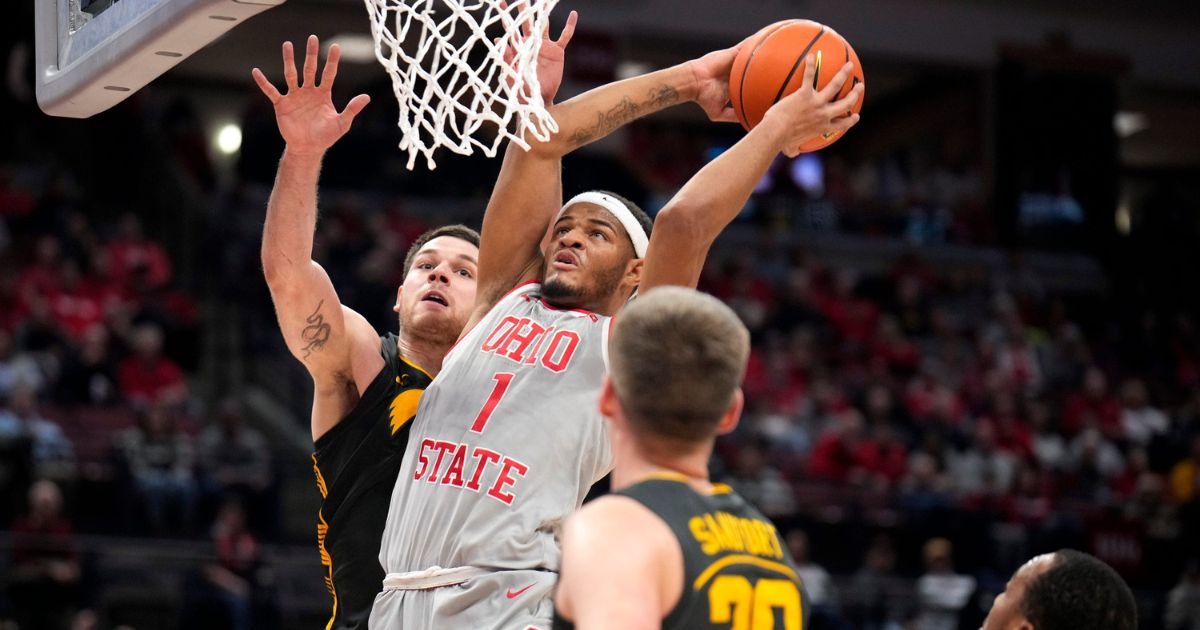By the Numbers: KenPom breakdown of where Ohio State stood in 2022-23

COLUMBUS — Ohio State was at the heart of a strange phenomenon in the advanced analytics world of college basketball last season.
Although the Buckeyes were caving in during the dog days of January and February — a stretch in which they lost 14-of-15 games — head coach Chris Holtmann’s team remained afloat in KenPom’s overall ranking system. And, for a good chunk of that spiral, Ohio State was still top 10 nationally in adjusted offensive efficiency.
Why the disparity between game-to-game results and metric standing? Well, KenPom’s Luck Rating is certainly a factor.
First thing’s first, KenPom is the name of a website created by Ken Pomeroy, and it serves as a statistical archive for every NCAA men’s Division I basketball team since the 2002 season.
Now, back to the Luck Rating, which KenPom defines as the “deviation in winning percentage between a team’s actual record and their expected record using the correlated gaussian method.”
Pomeroy noted: “The luck factor has nothing to do with the rating calculation, but a team that is very lucky (positive numbers) will tend to be rated lower by my system than their record would suggest.”
Conversely, as was the case with Ohio State last season, teams that aren’t very lucky (negative numbers) can be rated higher than their record would suggest. The Buckeyes’ Luck Rating of -120 was third-to-last in the country.
The Buckeyes lost nine games by six or fewer points last season. Four of those close defeats came during the first of their two five-game losing streaks. That alone makes you wonder what could have been had Ohio State won even just two of those four nail biters. Maybe the second skid — Ohio State’s longest losing streak since the program lost 17 straight amid the 1997-98 season — doesn’t happen?
It’s hard to say, but, what Lettermen Row can do is examine the rest of the 2022-23 Buckeyes’ KenPom ratings. Let’s dive in.
Adjusted Efficiency
Offense: 115.7 (19th)
Defense: 101.6 (106th)
TAKEAWAY: Ohio State is coming off its third straight season in which it ranked top 20 in adjusted offensive efficiency but 80th or higher in adjusted defensive efficiency. What’s more, in 2022-23, the Buckeyes were outside the top 100 in adjusted defensive efficiency for the second year in a row. Just three years ago, they were top 20 in both adjusted offensive and defensive efficiency, but that season was uprooted by the start of the COVID-19 pandemic.
Adjusted Tempo
Rating: 65.9 (247th)
Average possession length: 18.5 (279th)
Opponent average possession length: 17.9 (245th)
TAKEAWAY: The Division I average for possession length last season, according to KenPom, was 17.6 seconds. Ohio State was just about a second above that mark. That’s not too surprising considering the Buckeyes ranked 306th nationally with 6.4 fastbreak points per game. Particularly in the first half of the Big Ten slate, Ohio State struggled when opponents took away their first action, often leading to late shot clock isolations.
Four Factors
Effective field goal percentage:
Offense: 52.0% (89th)Defense: 48.9% (97th)
Turnover percentage:
Offense: 16.1% (50th)Defense: 15.9% (308th)
Offensive rebounding percentage:
Offense: 31.5% (88th)Defense: 28.6% (184th)
FTA/FGA (FTRate):
Offense: 26.6 (326th)Defense: 28.1 (96th)
TAKEAWAY: Ohio State’s elevated effective field goal percentage is noteworthy. KenPom says effective field goal percentage is “like regular field goal percentage except that it gives 50% more credit for made 3-pointers.” Well, that’s where it comes in handy that Ohio State shot 36.8% from downtown last season (more on that below). It’s important to point out, too, that, after a rocky start with ball security, the Buckeyes finished 50th in turnover percentage, per KenPom, and averaged only 10.7 turnovers per game, good for 31st nationally. For reference, they coughed up the ball 11.2 times per game in 2021-22. Despite the improvement in that department, though, Ohio State remained in the negative for turnover margin. A player like incoming Baylor transfer guard Dale Bonner, who averaged 1.4 steals per game while logging fewer than 20 minutes a night last season, should help in that area.
Miscellaneous Components
3-point percentage
Offense: 36.8% (38th)Defense: 32.1% (71st)
2-point percentage
Offense: 50.6% (164th)Defense: 49.3% (140th)
Free throw percentage
Offense: 73.9% (102nd)Defense: 72.3 (220th)
Block percentage
Offense: 7.1% (42nd)Defense: 10.2% (98th)
Steal percentage
Offense: 7.1% (8th)Defense: 7.8% (289th)
Non-steal turnover percentage
Offense: 9.1% (199th)Defense: 8.1% (277th)
TAKEAWAY: Let’s dive a bit deeper into Ohio State’s 50.6% 2-point percentage because it doesn’t tell the whole story. The Buckeyes reached a new low amid its season-changing slump. During that winter stretch, they ranked 321st nationally in 2-point percentage (46.2%), according to another college basketball advanced analytics site, BartTorvik. Additionally, Ohio State’s low opponent steal percentage lends itself well to the team’s aforementioned low turnover percentage.
Style Components
3PA/FGA
Offense: 31.7 (316th)Defense: 36.7 (160th)
A/FGM (assist rate)
Offense: 43.2 (348th)Defense: 49.1 (138th)
TAKEAWAY: Ohio State’s assist rate was putrid last season. The Buckeyes were 12th in the Big Ten and 283rd nationally with only 11.71 assists per game in 2022-23. Between Jan. 8 and Feb. 12, they registered double-digit assists in just two of their 11 outings. They averaged 8.3 assists per game in that span. To put that in perspective, Louisville was dead last in the country this past season with 9.3 feeders per contest. Ohio State notched more 15 assists in six games last year. All but one of those occurred before the start of 2023, and the other came in the Buckeyes’ resurgent Big Ten Tournament.
Point Distribution (% of total points)
3-pointers
Offense: 28.3% (264th)Defense: 30.0% (209th)
2-pointers
Offense: 55.9% (40th)Defense: 52.9% (109th)
Free throws
Offense: 15.9% (314th)Defense: 17.2% (236th)
TAKEAWAY: This brings us back to Ohio State’s 3-point percentage. Although the Buckeyes converted 36.8% of their long-range attempts last season, 3-pointers accounted for just 28.3% of their points. Meanwhile, 2-pointers — which they had immense difficulty with — made up more than half of their scoring. Holtmann wanted his team to take more 3-pointers down the stretch of the season. Some games, Ohio State did. Other games, Ohio State didn’t. But the Buckeyes shooting 44.6% from deep in the Big Ten Tournament can’t be ignored. Timely 3-pointers from Justice Sueing and Roddy Gayle Jr., who were a combined 19-of-30 from beyond the arc over those four games, went a long way.
Personnel
Bench minutes: 33.3% (112th)
D-I experience: 2.37 years (90th)
Minutes continuity: 12.4% (346th)
Average height: 77.4 inches (118th)
2-foul participation: 28.6% (104th)
TAKEAWAY: If you didn’t realize just how much roster turnover Ohio State was dealing with last year, the KenPom minutes continuity metric illustrates the stark change in team profile pretty well. But it’s not like the Buckeyes were inexperienced. They brought in three transfers, all of whom were seniors or grad students, and that’s not to mention Sueing, who was a sixth-year player. So while Ohio State was relying on four freshman starters by season’s end, the Buckeyes’ average of 2.37 years of D-I experience demonstrates that Ohio State wasn’t quite as “young” as you’d might think.
The post By the Numbers: KenPom breakdown of where Ohio State stood in 2022-23 appeared first on On3.
